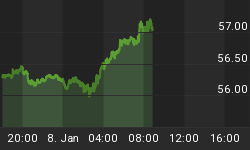The big, big problem with the whole subprime/CDO/Armageddon market thing is that while the values on these assets can go down, the debts incurred to buy the assets don't. In fact, the debts remain theoretically constant.
From Cornerstone Investment Services comes the informative essay, "Debt, the Unseen Killer", which reminds us that the Federal Reserve's stupid little monetary policy equations are wrong because, "The variable that the monetarists ignore is debt. They believe that as long as the cost of the debt (interest rate) is low, debt is irrelevant. But what they ignore is the size of the debt and the relationship of debt to the economy and markets. They ignore how heavy a burden debt is for the economy."
How heavy? They write "Relative to the economy, the debt load has never been higher. The last time it was even close to this level, the Depression in the 1930's followed." Yow!
Then we get a little more scary market lore, as, "the liquidity that is supposedly sloshing around in mutual funds isn't likely to save the day either."
And what does this actually mean? "Market bottoms," Cornerstone says, "are usually associated with high cash positions in mutual funds. Market tops are associated with low cash levels."
So what is the cash level in mutual funds now? "The cash position in [the] year 2000 was lower than right before the Crash in '87, and the same as the market top of 1972, right before the market dropped 50% over a 2 year period. Today's cash position? Lower than both of those, the lowest in history." Oops! We're freaking doomed!
Paul Kasriel, Director of Economic Research of Northern Trust, hears us talking about this indicator stuff, and suggests looking at another model, which he says, "has a better track record in forecasting recessions." What is this fabulous predictive model? It's a "combination of the behavior of a yield spread and the CPI-adjusted monetary base."
Well, as soon as I heard there were going to be two complicated variables to keep track of, I started losing interest, but in case you are made of sterner stuff, the yield-spread variable is "the difference between the yield on the Treasury 10-year security and the federal funds rate", while the other variable (the monetary base) "consists of the reserves created by the Federal Reserve for the banking system and the currency held by the public."
It seems that if you put all of this stuff together, you will see that "since 1970, whenever the four-quarter moving average of the yield spread has turned negative and, at the same time, the year-over-year change in the quarterly average of the CPI-adjusted monetary base has turned negative, a recession has occurred."
I had just made up my mind to get the hell out of there because just keeping track of that many variables sounds complicated and suspiciously like work, and I can clearly see that this is leading up to him asking me a question to test if I am understanding what he is saying, and of course I don't, and so who needs that crap?
Fortunately, Mr. Kasriel can tell just by looking at me that I am a "special needs" person, and gets right to the point, which is that, "In each of the first two quarters of 2007, this combination of a negative yield spread and contracting real monetary base" has been "obtained."
And what did all of this debt actually accomplish? To add to the list of benefits that all this debt has produced, like having a recession coming, (and probably a depression, too), Cornerstone says, "In the 1950's, every dollar of new debt produced over $4.00 of economic activity. But by Year 2000 it had dropped to 20 cents of GDP growth and only 10 cents by 2005. Last month fell to only a nickel of economic growth for every dollar of debt growth." Hahaha! Nice investing there, dudes!
** And even if the economy has collapsed, people are getting laid off, nobody is making any money, bankruptcies and foreclosures are pandemic, lava is running in the streets, zombies are rising from their graves, and mutant spores from outer space are eating our brains, the insatiable American consumer is not going to let anything as minor as "lack of income" stand in his/her way of gorging on shiny toys, geegaws, gimcracks and doo-hickies, thus explaining why Consumer Installment Credit jumped by a huge $13 billion in June, taking that measure of debt to a hefty, hefty $2.459 trillion. Ugh.
Mogambo sez: Ahh, gold! Ahh, silver! Ahh, oil! That's how you spell relief from the screaming heebie-jeebies, which 9 out of 10 doctors know is a wild and manic condition that direly afflicts those who have a clue as to what is happening to their money and their retirements.
So, are you are starting to panic, too? Don't suffer needlessly! Get some gold, silver and oil today, and let all your financial cares drift painlessly away!
P.S. To get The Daily Reckoning sent directly to your inbox, sign up for our free email newsletter, or if you prefer to use RSS, subscribe to the Daily Reckoning RSS feed.
















